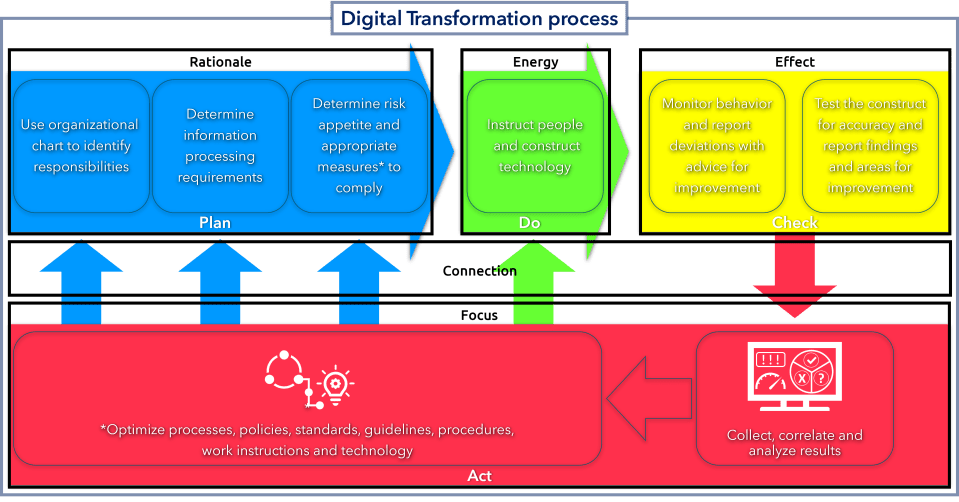Introduction
In the landscape of business innovation, digital transformation is emerging as the central protagonist, reshaping the dynamics of organizational operations. This paradigm shift redirects the focus of process execution and information processing from traditional human-centric methods to innovative technological solutions. The exponential growth of technological applications empowers organizations to streamline information processing through digitization, facilitating the efficient realization of business processes and objectives.
Now, we are approaching (and sometimes surpassing) a critical tipping point: With digitization, and technological innovation, organizations start to automate even the most complex ways of information processing: Information processing that has long relied on the cognitive abilities and interpretive skills of individuals with specific domain knowledge.
This evolution necessitates a careful and thorough approach to digitization and automation. However, organizations are increasingly prone to misconstrue technology as an end goal rather than a supportive tool. This confusion is understandable, given that technology enables the rapid achievement of organizational objectives. There’s an expectation that technology itself can spur exponential organizational growth.
How this Confusion Arises
- Organizations are progressively shifting the execution of processes and information processing towards technology. A significant challenge arises as organizations often conflate information with data. This confusion leads many organizations to delegate responsibility for information processing to the technical (IT) domain. Consequently, technology and tools take precedence over information processing, resulting in decisions that align with the capabilities of chosen technologies rather than the organization’s overarching objectives.
- Information is abstract. Each individual approaches information through their own unique background and perspective, leading to potential discrepancies in interpretation. In digitization efforts, it’s imperative to structure information in a manner that minimizes the possibility of misinterpretation. Therefore, the accurate processing of information hinges on two critical factors:
- The clarity of the presented information, as vagueness increases the risk of misinterpretation.
- The perspective of the individual processing the information.
- Information, within organizational processes, follows specific flows, involving various departments and individuals in the processing chain. Identifying multiple owners within these information flows adds complexity to digitization efforts. Recognizing information objects and assigning them to the appropriate owners optimizes processes by facilitating coordination. However, many organizations designate information ownership within the technical domain, making the challenge even more difficult.
Example from Personal Experience:
I frequently encountered these challenges in my work as a consultant. For instance, I recently collaborated with a large construction company to explore the potential of Artificial Intelligence (AI) in their operations. Construction firms face intense competition, with rivals sometimes doubling as partners or subcontractors.
Key challenges
The company sought AI solutions to address key challenges, including:
- Communicating ‘just enough’ information with competitors during projects without compromising proprietary methods (‘crown jewels’).
- The problem of fragmented technical tools used across different departments and companies makes interoperability challenging, and sometimes even impossible. The current approach is that, when transitioning to a next project phase, all prior information is manually inputted into the tools used for the new phase. This essentially means starting afresh each time.
Main take aways
After in-depth discussions with AI experts, we reached several conclusions:
- Regarding the first challenge, we emphasized the importance of classifying information to distinguish between confidential and non-confidential information. Establishing processes for such classification is essential, as AI cannot autonomously discern the sensitivity of information.
- Regarding the second challenge, we reframed the issue, highlighting that interoperability between different tools wasn’t the issue: The fragmentation of tools impeded efficiency. AI could streamline operations by mapping outcomes to project specifications, provided clear guidelines were established. Unfortunately, they were not.
How to tackle these challenges
These examples underscore the need for organizations to understand analog information processing before embarking on digital transformations. In both cases, human expertise is mandatory to ensure technological advancement. While AI presents promising solutions, its effectiveness ultimately hinges on human judgment and discretion. Without the human perspective to guide its implementation and decision-making, AI alone cannot fully address the complexities and nuances of organizational challenges. Thus, organizations must recognize and leverage the evolving symbiotic relationship between human expertise and technological innovation to achieve optimal results.
In the case of the construction company, it meant that they needed to find ways to classify information in such a way that AI is able to recognize it. Additionally, they had to establish clear guidelines for AI to adhere to, facilitating the mapping of results from various tools with these guidelines. However, implementing this is easier said than done.
How to Successfully Digitize Your Organization
First, let’s define digitization:
Digitization enables people and organizations to process information optimally (more efficiently and effectively) through the application of technology.
For organizations, digitization yields several common outcomes:
- Organizational change: Digitization necessitates rethinking and redesigning responsibilities, processes, structures, and cultures to leverage digital technologies effectively.
- Enhanced user experience: Digitization allows for more personalized, relevant, and seamless experiences, often facilitated by digital channels and data analysis.
- Increased flexibility and resilience: Digitization enables organizations to adapt and remain competitive amidst changing technological trends, market conditions, and user needs.
Where to Start
Initiate organizational change proactively, aligning it with the overarching goal of digital transformation. Adjusting your organization beforehand streamlines the digitization process. But what does this new organization entail? Where should the focus lie, and how do you steer accordingly? Establishing the following points ensures your organization is equipped to navigate digital transformation successfully:
- Ownership of Information: Understand how information processing occurs within your organization, and try to approach this ‘as if technology doesn’t exist’. This helps to easier identify who owns which information to steer its processing effectively. The construction company in my example would benefit from this, as it would make it clear whom to turn to, whilst digitizing information.
- Understanding Information Flows: Recognize information flows within business processes and functions, making them tangible for successful digitization. The construction company would benefit, because it makes it possible to understand where and when steps are taken within the process, and how the handover between phases occur, making it possible to translate them to the digital environment.
- Establishing Processing Requirements: Define clear requirements and objectives for processing information within business processes and functions. The construction company benefits, because this also establishes proper insight in confidentiality. Furthermore, this makes it possible to properly map guidelines with outcomes.
- Dealing with Deviations: Determine how to manage deviations from processing requirements. Be prepared to adjust based on evolving insights and developments. The construction company benefits from this, as it allows them to quickly steer on unforeseen, or unwanted outcomes.
- Establishing Measures to Prevent Deviations: Implement clear work instructions, policies, standards, and procedures to prevent deviations from processing requirements. This is input for choosing and developing technologies that really fit the digitization of the organization. The construction company benefits from this, as its digital environment will be constructed in line with company goals and objectives.
Benefits
By implementing these changes, organizations pave the way for successful digital transformation. This methodology establishes the rationale behind digitization, enabling you to put energy into wat is relevant and aligned with your organization’s goals, focusing on effects that need attention. This approach also ensures that there is always a connection between rationale, energy , effect and focus. This connection facilitates a Plan-Do-Check-Act (PDCA) cycle, ensuring flexibility and robustness in the face of continuous change.
The following figure illustrates the above described approach:

Conclusion
While digital transformation presents boundless possibilities, it’s crucial to view it as a means to achieve the organization’s real goals and objectives. A revised organizational structure, prioritizing information processing and ownership, is essential for successful digitization. By emphasizing information processing and establishing clear ownership, you gain insight into optimizing processes by process automation, selecting technologies in alignment with your goals and objectives.

 English | EN
English | EN 
